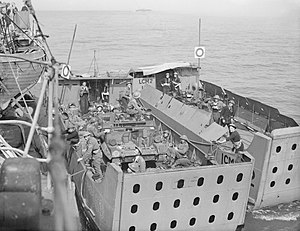LCM 1

Two examples of the LCM(1) on an exercise prior to the 1942 Dieppe Raid. On the right is an earlier model without the later fully armoured steering shelter. This craft also has been given additional armour around the tank well and a ramp extension.
|
|
| Class overview | |
|---|---|
| Name: | Landing Craft Mechanised Mark 1 |
| Builders: | John I. Thornycroft Ltd. and others |
| Operators: | |
| Preceded by: | Motor Landing Craft |
| Succeeded by: | LCM (3), LCM (4), LCM (7) |
| Built: | 1938–1944 |
| Completed: | ~500 |
| Active: | 0 |
| Lost: |
|
| General characteristics | |
| Type: | Landing craft |
| Displacement: | 21 long tons (21,337 kg) |
| Tons burthen: | 16 long tons (16,257 kg) |
| Length: | 48.5 ft (14.8 m) |
| Beam: | 14 ft (4.3 m) |
| Draught: |
|
| Ramps: | 1 |
| Propulsion: | 2 × 60 bhp Thornycroft petrol engines (later Chrysler) |
| Speed: | 10 kt (light), 6 kt (loaded) |
| Range: | 50–80 miles |
| Crew: | Six: coxswain, stoker, and four seamen, plus one officer per group of three boats |
| Armament: | 2 × Lewis Guns |
| Armour: |
|
| Notes: |
|
The Landing Craft, Mechanised Mark 1 or LCM (1) was a landing craft used extensively in the Second World War. Its primary purpose was to ferry tanks from transport ships to attack enemy-held shores. Ferrying troops, other vehicles, and supplies were secondary tasks. The craft derived from a prototype designed by John I. Thornycroft Ltd. of Woolston, Hampshire, UK. During the war it was manufactured in the United Kingdom in boatyards and steel works. Constructed of steel and selectively clad with armour plate, this shallow-draft, barge-like boat with a crew of 6, could ferry a tank of 16 long tons to shore at 7 knots (13 km/h). Depending on the weight of the tank to be transported the craft might be lowered into the water by its davits already loaded or could have the tank placed in it after being lowered into the water.
Narvik and Dunkirk claimed almost all of the 1920s Motor Landing Craft and, therefore, the LCM(1) was the common British and Commonwealth vehicle and stores landing craft until US manufactured types became available. Early in the war LCM(1) were referred to commonly as Landing Barges by both the military and the press. Prior to July 1942, these craft were officially referred to as "Mechanised Landing Craft" (MLC), but "Landing Craft; Mechanised" (LCM) was used thereafter to conform with the joint US-UK nomenclature system. This being the earliest design in use at the time, it was more specifically called “Landing Craft, Mechanised Mark 1” or LCM(1).
All landing craft designs (and landing ship designs for ships intended to beach) must find a compromise between two divergent priorities; the qualities that make a good sea boat are opposite those that make a craft suitable for beaching.
In 1938, following the Inter-Service Training and Development Centre ’s (ISTDC) successful development of the infantry carrying LCA and close support LCS, attention turned to the means of efficiently delivering a tank to a beach. Inquires were made of the army as to the heaviest tank that might be employed in a landing operation. The army wanted to be able to land a 12 ton tank, but the ISTDC, anticipating weight increases in future tank models specified 16 tons burthen for Mechanised Landing Craft designs. The Mercantile Marine Department of the Board of Trade informed the ISTDC that for the new craft to be carried aboard the ordinary heavy-derrick merchant ship, it would need to be limited to 20 tons, no more than 40 feet in length, and 14 feet in beam. Another governor on any design was the need to land tanks and other vehicles in less than approximately 2 ½ feet of water. Design work began at Thornycrofts in May 1938 with trials completing in February 1940.
...
Wikipedia
